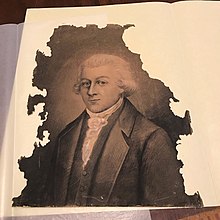Charles Philippe Aubry
Charles-Philippe Aubry | |
|---|---|
 Posthumous portrait by Isnard Osicran, (c. 1905) | |
| 13th French Governor of Louisiana | |
| In office 1765–1768 | |
| Monarch | Louis XV |
| Preceded by | Jean-Jacques Blaise d'Abbadie |
| Succeeded by | Antonio de Ulloa As Governor of Spanish Louisiana |
| 2nd Spanish Governor of Louisiana | |
| In office 1768–1769 | |
| Monarch | Charles III |
| Preceded by | Antonio de Ulloa |
| Succeeded by | Alejandro O'Reilly |
| Personal details | |
| Born | circa 1720 France |
| Died | February 17, 1770 at sea near Garonne, France |
| Military service | |
| Allegiance | |
| Years of service | 1742–1770 |
| Rank | Captain |
| Battles/wars | |
| Awards | Order of Saint Louis Chevalier |
Charles-Philippe Aubry or Aubri[1] (died February 17, 1770) was a French soldier and colonial administrator, who served as governor of Louisiana twice.
Career
[edit]Aubry began his military career in 1742, when he was commissioned as a second lieutenant in the Lyonnais Infantry Regiment. After serving in the War of the Austrian Succession as an officer of grenadiers, Aubry left France to take a commission as a captain of colonial troops in Louisiana.[2] During the French and Indian War, he was the commander of the French forces at the Battle of Fort Ligonier.[3] He was later captured and imprisoned by the British after the French defeat at the Battle of La Belle-Famille.[4] After his release, he was made a Chevalier de St. Louis and military commander of Louisiana.
Aubry succeeded Jean-Jacques Blaise d'Abbadie as colonial governor of Louisiana in 1765 after d'Abbadie died in office. During his term, he met with members of the exiled Acadian community under Beausoleil and encouraged them to settle in the Attakapas Territory, where there were abundant grasslands available for development of a local cattle industry.[5][6] Aubry was followed as governor by the Spaniard Antonio de Ulloa, and served as acting governor again after the latter's expulsion in the Louisiana Rebellion of 1768. After the arrival of a replacement Spanish governor Alejandro O'Reilly, Aubry reportedly provided him with the names of some of the conspirators in the rebellion.[7] Soon afterwards, Aubry left for France on the Père de Famille, but died in a shipwreck within sight of the French coast.[8]
In 1920, the city of New Orleans named a street after him (Aubry Street), one block from D'Abadie Street.[9]
References
[edit]- ^ Lacoste, Elaine (1997). Street Names & Picayune Histories of New Orleans. Honolulu, Hawaii: Hoʻolauna Hawaii. p. 6. ISBN 0-9656409-0-6. OCLC 37013130.
- ^ Brasseaux, Carl A. (1990). Dawson III, Joseph G. (ed.). The Louisiana Governors: From Iberville to Edwards. Baton Rouge, Louisiana: LSU Press. pp. 41–43. ISBN 0-8071-1527-4. OCLC 20422628.
- ^ J.C.B. (1986). "Voyage to Canada". In Harpster, John W. (ed.). Crossroads, Descriptions of Western Pennsylvania, 1720–1829. Pittsburgh, Pennsylvania: University of Pittsburgh Press. p. 42. ISBN 0-8229-6088-5. OCLC 12420486.
- ^ Peckham, Howard H. (1964). The Colonial Wars, 1689–1762. Chicago, Illinois. p. 183. ISBN 978-0-226-65313-6. OCLC 1175484.
{{cite book}}: CS1 maint: location missing publisher (link) - ^ Carl A., Brasseaux (1987). The Founding of New Acadia: The Beginnings of Acadian Life in Louisiana, 1765-1803. Baton Rouge, Louisiana: LSU Press. p. 74. ISBN 9780807141632.
- ^ Brasseaux, Carl A. (2011). Acadiana : Louisiana's Historic Cajun Country. Baton Rouge, Louisiana: LSU Press. ISBN 978-0-8071-3964-6. OCLC 714617934.
- ^ Cowan, Walter G. (2008). "Charles Philippe Aubry". In Cowan, Walter G.; McGuire, Jack B. (eds.). Louisiana Governors: Rulers, Rascals, and Reformers. Jackson, Mississippi: University Press of Mississippi. p. 35. ISBN 978-1-60473-320-4. OCLC 503441538.
- ^ Beers, Henry Putney (2002). French and Spanish Records of Louisiana: A Bibliographical Guide to Archive and Manuscript Sources. Baton Rouge, Louisiana: LSU Press. p. 16. ISBN 9780807127933.
- ^ Asher, Sally (2014). Hope & New Orleans: A History of Crescent City Street Names. Charleston, South Carolina: Arcadia Publishing. p. 36. ISBN 978-1-62584-509-2. OCLC 884339021.


